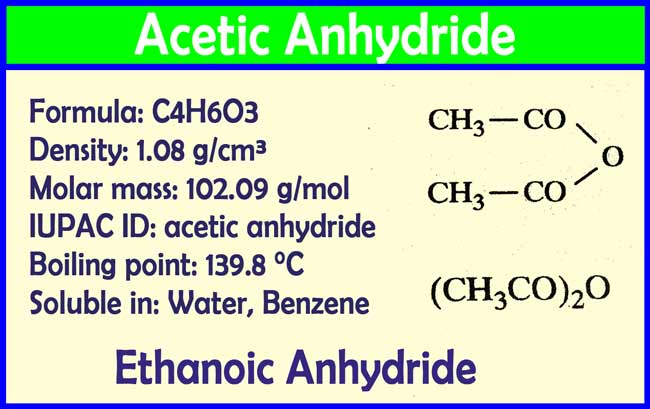Acetic Anhydride: What is acetic anhydride used for?| Preparation | Properties
Acetic Anhydride or Ethanoic Anhydride
Preparation of Acetic Anhydride
Acetic acid: By heating acetic acid with phosphorus pentoxide, one of its two molecules removes water and forms acetic anhydride.
2CH3COOH + P2O5 → (CH3CO)2O + H2O
Laboratory Method: In the laboratory, acetic anhydride is obtained by distillation of a mixture of acetyl chloride and anhydrous sodium acetate.
CH3COCl + CH3COONa → (CH3CO)2O + NaCl
Method: Take about 50 grams of anhydrous sodium acetate powder in a distillation flask and arrange it with a point funnel, condenser and receiver. Take about 40 grams of acetyl chloride in the funnel and pour it slowly into the flask.
At this time, keep the flask in cold water. After adding complete acetyl chloride, shake the flask thoroughly and place it on the sand boiler.
The flask is heated to 135-140°C to distill the mixture kept in it. The acetic anhydride is distilled and collected in the receptor. The anhydrous calcium chloride placed in the receptacle’s lateral tube absorbs air moisture and does not allow it to come in contact with acetic anhydride.

A small amount of anhydrous calcium acetate added to the acetic anhydride thus obtained gives a pure acetic anhydride upon re-distillation.
A small amount of anhydrous calcium acetate added to the
acetic anhydride thus obtained gives a pure acetic anhydride upon
re-distillation.
Industrial Manufacture: A commercial quantity of acetic anhydride is obtained by the following methods.
On heating an excess of anhydrous sodium acetate with thionyl chloride, acetyl chloride is first formed which reacts with the remaining sodium acetate to form acetic anhydride.
CH3COONa + SOCl2 → CH3COCl + SO2 + NaCl
CH3COONa + CH3COCl → (CH3CO)2O + NaCl
Ethylidene acetate is obtained when acetylene gas is precipitated in the glacial acetic acid in the presence of a marcuric sulfate catalyst whose distillation in the presence of zinc chloride yields acetic anhydride.
CH≡CH + 2CH3COOH → CH3CH(CH3COO)2
CH3.CH(CH3COO)2 → (CH3CO)2O + CH3CHO
Physical Properties
It is a colorless, pungent odor, less soluble in cold water and soluble in ether and benzene. Its boiling point is 139.5°C and relative density is 1.087.

Chemical Properties
The chemical reactions of acetic anhydride are similar to acetyl chloride but are less reactive than acetyl chloride. Following are its major chemical reactions.
Water Decomposition: It does not decompose with cold water. At normal or high temperatures, this water decomposes to form acetic acid.
(CH3CO)2O + H2O → 2CH3COOH
Acetylation: Like acetyl chloride, it reacts with compounds containing -OH and -NH2 group and displaces the hydrogen atom by acetyl group. Since it is less reactive than acetyl chloride, H2SO4 or sodium acetate are used as catalysts in its acetylation reaction. Following is its major acetylation reactions.
Reactions with alcohols: It reacts with alcohols to form ester.
(CH3CO)2O + C2H5OH → CH3COOC2H5 + CH3COOH
Reaction with ammonia: By acting with ammonia, it forms acetamide.
(CH3CO)2O + NH3 → CH3CONH2 + CH3COOH
Reaction with primary and secondary amines: By reacting with primary and secondary amines, it forms N substituted acetamide.
(CH3CO)2O + C2H5NH2 → CH3CONH2 + CH3COOH
(CH3CO)2O + (C2H5)2NH → CH3CON(C2H5)2 + CH3COOH
Reaction with hydrogen chloride: It reacts with dry hydrogen chloride gas to form acetyl chloride and acetic acid.
(CH3CO)2O + HCl → CH3COCl + CH3COOH
Phosphorus pentachloride: It reacts with Phosphorus pentachloride to form acetyl chloride.
(CH3CO)2 + PCl5 → 2CH3COCl + POCl3
Reduction: It is reduced by lithium aluminum hydride to form ethanol.
(CH3CO)2O + LiAlH4 → 2C2H5OH + H2O
The above reduction can also be done by H2/Ni, Na/alcohol or NaBH4.
Acetic Anhydride Uses
To find the number of -OH and -NH2 groups in carbonic compounds,
As acetylation reagent in the manufacture of carbonic compounds,
In the manufacture of pigments and medical such as Aspirin
As reagent in the laboratory.
